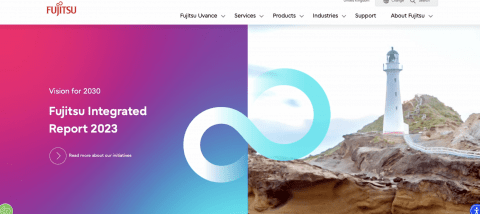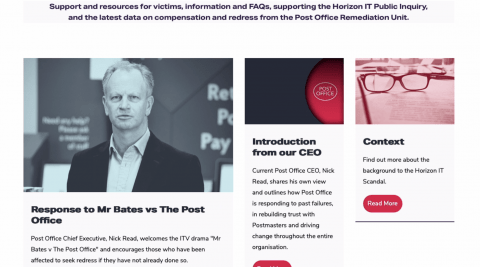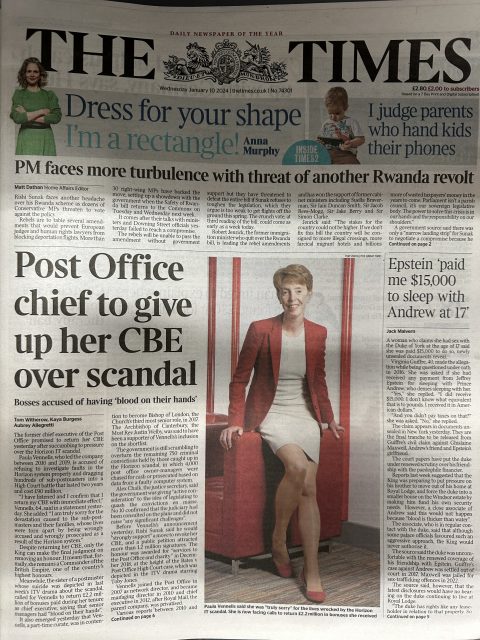Are you one of those senior people who knows that one day you, or your company, might find yourselves at the eye of a media storm? A well paid member of the C-suite, perhaps, or someone paid to handle the media on the C-suite’s behalf?
If so, I hope these observations on the recent Post Office scandal might help you decide on your own approach if that difficult day comes.
(It’s a fairly long read, but I hope an arresting one that it might be worth hanging onto. You never know when the storm is going to break about your head.)
My observations are based on what I’ve witnessed as a BBC News journalist — and, more recently, on my experience as a media trainer helping companies work with journalists.
The Post Office Scandal offers us three approaches you could choose. But I’ll suggest there’s a fourth that might work better.
1 The “Head in Sand, Fingers in Ears” Approach

Fujitsu’s homepage: “Nothing to see here”
This has been demonstrated spectacularly by Fujitsu, the company whose software is now known to have caused the bugs that created the misery at the heart of the story.
On January 9, I scanned their website to see what their response to this was.
Their homepage simply didn’t mention it. ‘NOTHING TO SEE HERE’ was the overall impression.
Instead, a picture of a lighthouse and a declaration of a Vision for 2030.
I tried their News pages. I clicked a link to their Press Releases. Surely, I thought, there’d be something?
The latest Press Release, on any topic at all, was July 2022, celebrating a Gold Award at a Customer Experience event.
I called their Press Officer. (At least he’d had the courage to put a phone number on the page.) He picked up. We had an amicable chat, and he explained to me that the company’s policy was simply not to comment publicly — although he would issue a brief statement ‘on request.’
Within four minutes, he’d sent it to me. I repeat it in full:
The current Post Office Horizon IT statutory Inquiry is examining complex events stretching back over 20 years to understand who knew what, when, and what they did with that knowledge. The Inquiry has reinforced the devastating impact on postmasters’ lives and that of their families, and Fujitsu has apologised for its role in their suffering. Fujitsu is fully committed to supporting the Inquiry in order to understand what happened and to learn from it. Out of respect for the Inquiry process, it would be inappropriate for Fujitsu to comment further at this time.”
My thoughts, as a journalist-turned-media trainer?
The ‘head in sand’ approach is very high risk. It suggests indifference bordering on contempt. From a business point of view, it is also likely to put new clients off — as they assess whether your company is even in touch with reality. Issuing a brief statement available only on request to reporters who can track down a Press Officer’s details — albeit one that does acknowledge the crisis and demonstrates empathy— becomes almost meaningless.
2 The Head Visible, Body in Sand approach

You have to click a lot of links to find it
This is demonstrated by the Post Office.
Again, I was curious to see what they put about this on their website on the same day, as the media storm swirled around them and Downing Street started to notice.
Once again, I was led a merry dance trying to find anything.
No mention of anything newsworthy at all on the homepage. Instead, a handy guide to returning your Christmas presents.
Determined, I scrolled down, spotting a link to the ‘Corporate Website’.
Clicking on this — aha! — fourth from the right, a tab that actually acknowledged what had happened … ‘The Horizon IT Scandal.’
Beyond this lay another link to a web-article acknowledging the ITV programme that had finally brought all this bursting into the open.
This article is entitled: “A Response to Mr Bates v The Post Office”, and claims that the current Chief Executive welcomed the programme.
And within this link — I could barely believe my eyes — a video message from him, filmed before the programme had been broadcast, but clearly acknowledging its power and that it needed to be taken seriously.
My Thoughts, as a Journalist turned Media Trainer?
If you’re going to make the ‘head visible’, and go to the trouble of recording a message with the CEO, put it front and centre.
By hiding it so deep within your website, you give the impression that you want the credit for recording an empathetic message from a kind sounding leader — without having the courage to put it in front of the widest possible audience.
3 The “Hands Up, I Get It” Approach

“Sorry” makes the front page
This was demonstrated by the former Chief Executive of the Post Office, Paula Vennells, after several days of relentless pressure.
Her name was mud in the tabloids, more than a million people had signed a petition to have her CBE removed, and the Prime Minister was by now comfortable stating publicly he felt it should be considered.
There was no video message on YouTube or appearance on in front of news cameras, but — after several days in hiding — there was this statement issued to all media. It was the next day’s front page news for the press.
“I have so far maintained my silence as I considered it inappropriate to comment publicly while the Inquiry remains ongoing and before I have provided my oral evidence.
“I am, however, aware of the calls from sub-postmasters and others to return my CBE.
“I have listened and I confirm that I return my CBE with immediate effect.
“I am truly sorry for the devastation caused to the sub-postmasters and their families, whose lives were torn apart by being wrongly accused and wrongly prosecuted as a result of the Horizon system.
“I now intend to continue to focus on assisting the Inquiry and will not make any further public comment until it has concluded.”
My Thoughts, as a Journalist turned Media Trainer?
This demonstrates that hiding behind the excuse that “a public inquiry is underway” will no longer wash.
Paula Vennells finally had the grace to admit that too much harm had been done for her to remain silent. She displays an element of empathy. She doesn’t hide behind bland words, but chooses to use strong ones: ‘devastation’, ‘torn apart’ and, the biggie, ‘sorry’.
I have little sympathy for Mrs Vennells. But I do respect her wisdom in having the courage to come out of hiding. It meant, of course, that she remained in the news spotlight — but she had taken some control of that spotlight, and that, in my judgment, reflected well on her.
If you’ve read this far, you may be shouting at me — “but John, my company pays lawyers vast sums and they tell me in no uncertain terms that I should not to say a word in a situation like this.”
I think the time has come to suggest that perhaps such certainty from lawyers is part of the problem.
It creates the culture of control, paralysis and fear that may have got Fujitsu and the Post Office in this mess in the first place.
Yes, the legal stakes are indeed high right now for many managers at Fujitsu and the Post Office. Criminal convictions are being breathlessly discussed in the media. It’s never a good look when your crisis leads to emergency legislation in Parliament.
As I write, I have in the corner of my eye the Public Inquiry hearings, now broadcast live on the BBC News website.
So let me end with an example of a Japanese company that did take a different approach when the stakes, too, were very high indeed.

Toyota takes a bow ©NBC
In 2010, Toyota had to recall 8.5 million cars, because of potentially fatal defects.
Here’s what the President, Akio Toyoda, did, albeit after some dithering.
He apologised to customers, and to the US Congress. (It’s reported that he offered his condolences to the families of those who may have died or been injured as a result of those defects, though I haven’t been able to confirm this for myself.)
He bowed before news cameras.
And an ad campaign was created, admitting the company he led hadn’t lived up to its safety standards, and explaining how those issues would be fixed.
There’s still time for Fujitsu and the Post Office to take this “we are to blame, actually” approach.
It takes courage.
But perhaps it’s time for their managers to now face the fear and show that courage.
It’s what their victims have been doing for more than twenty years.